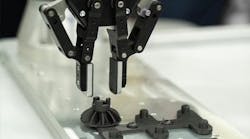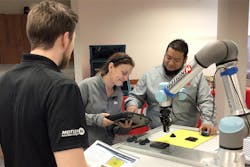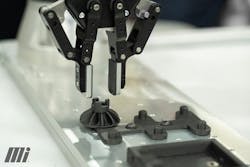Innovations in manufacturing automation are constantly emerging to improve efficiency and productivity, and collaborative robots (cobots) are one of the fastest growing.
The main difference between industrial robots and cobots is the human element. Industrial robots operate in an isolated and safeguarded work envelope and often replace human labor, while cobots work alongside their human coworkers, facilitating safer and more flexible production processes. Compared to industrial robots, cobots are generally smaller and equipped with power- and force-limiting components in the joints to help detect collisions and stop safely.
Successfully integrating cobots into the plant environment requires carefully considering several factors to ensure efficiency and safety. This article explores the key considerations when installing, operating and maintaining cobots in industrial settings.
Evaluate and identify your needs
Like any tool, cobots can be used for many tasks, but defining the scope of what you want to achieve as early as possible is essential. Before diving into robotics or automation in general, you must know your current system. This typically means collecting data using lean tools like value-stream mapping (VSM). Once you have your data, identify areas for improvement; they are often your bottlenecks or quality concerns. Then conduct a return-on-investment study to identify the task that benefits the most from automation.
Analyze all data collected during the VSM and determine the key performance indicators (KPIs) required to complete that task, such as payload, throughput, precision, and repeatability. The right technology choices and integration plan design will be based on this assessment.
Design and plan your system
Once you have identified your system needs, the next step is designing and planning the system. This phase involves selecting the right components and the best robot design solution that align with your project requirements.
Considering the compatibility of new equipment with your current production equipment is crucial (see Figure 1). New automation technologies require upgrading other hardware or software that will interact with the latest equipment. Projects often require redesigning the current processes, layouts or procedures.
A detailed plan should outline every system aspect, including components, integration, timelines, budget, training needs and potential risks.
- Workspace design and layout: Workspace layout is pivotal in facilitating seamless collaboration between a cobot and its human coworkers. Designing workstations with clear delineation between human and cobot-operated areas minimizes the risk of collisions. Incorporating ergonomic principles enhances the comfort and efficiency of human workers interacting with cobots, improving productivity and employee satisfaction.
- Risk assessment, safety regulatory compliance and documentation: One of the most important steps is conducting a comprehensive risk assessment of cobot deployment. Ensuring compliance with safety standards such as ISO 10218 and ISO 15066 is essential to guarantee safe operation around humans. Implementing built-in safety features such as force limiting, speed control and presence sensing can prevent accidents and injuries. Maintaining detailed documentation of cobot installations, operations, maintenance procedures and safety protocols is required for regulatory purposes and auditing. Keeping informed about updates and changes to regulations and standards enables prompt adaptation of cobot systems and practices.
- Selecting the right equipment: Ensure you have the right cobot and peripherals for optimizing the overall system. Start by finding the requirements for your cobot; this includes but is not limited to payload capacity, reach, speed and repeatability, plus the programming environment associated with the cobot. Once these details are identified, research the technical specifications of different cobots on the market that match your requirements. Lastly, confirm the cobot can adequately communicate with your existing systems or that you have a feasible plan to make it compatible with peripheral equipment. Most importantly, choose something easy to use without retraining the entire workforce or redefining your whole process.
- End-of-arm tooling (EOAT) and grippers: Selecting the appropriate end-of-arm tooling and grippers based on specific tasks and applications is critical for cobot performance (see Figure 2). Compatibility and ease of integration between cobots and EOAT minimize downtime and optimize efficiency. Many off-the-shelf adaptive grippers have connection software with the robot developed, like a driver for your PC. The manufacturer produces the driver to control the EOAT or the gripper more easily. Adaptive grippers can be effectively used for multiple parts or actions, leading to time savings (from tool changeovers, design and construction) and long-term costs. Lastly, consider adding quick tool changers to all EOAT to reduce your future maintenance or changeover times.
-
Safety components: Not all cobots are the same. Confirm that the cobot specifications meet regulatory and industry standards to truly make them collaborative robots. Consider using power- and force-limiting cobots to maximize your collaborative environment. Decide what external safety components your system needs. The robot may be collaborative, but the robot task or part being handled may not be and can still lead to worker injuries. Common safety components often used with cobots include multi-level safety laser scanners and light curtains for hard system stops or partial caging. Safety laser scanners can seem expensive as a singular product, but they can protect workers, equipment and mobile systems within a user-defined area. Continuously scanning a wide range up to a 275° area, they create a two-dimensional protected zone that must be crossed before reaching the hazard/stop level.
-
Programming and integration: User-friendly programming interfaces are essential for cobot programming by operators with varying levels of technical expertise. Integrating cobots with existing production systems, machinery and software streamlines operations and maximizes productivity while minimizing costs. Adequate training and support for personnel responsible for programming and maintaining cobots ensure optimal performance and efficiency.
Develop a maintenance and troubleshooting schedule
A comprehensive maintenance schedule is essential to keep cobots in optimal condition and minimize unplanned downtime. Refer to the cobot’s manual to develop a routine preventive maintenance (PM) plan. Create your own inspection plan to check for damage or abnormal motion/sounds. Most importantly, note if the owner’s manual calls for specific tasks such as lubrication and calibration of cobots and associated equipment. Attending to these ongoing tasks will keep your cobot running as intended for as long as possible.
Create troubleshooting guides and access to technical support for maintenance and line workers to enable timely resolution of issues, minimizing disruptions to production and maximizing uptime. Lastly, remember to regularly inspect and maintain EOAT to prevent wear and tear, ensuring consistent performance and reliability along with the cobot.
Common tips for maintaining your cobot should include:
- Grease all joints and gears if called out in the owner’s manual.
- Check and clean the robot, including the arm, wiring, tooling and pedestal/base.
- Replace filters on cooling fans and vents (if needed).
- Check for leakage caused by worn seals.
- Clean the EOAT, sensors and other safety components.
- Replace the battery on encoders if required.
- Watch and listen to the robot in motion. Mechanical problems in the joints can often be heard as abnormal sounds.
The above tips should be performed regularly and comprise the core of your preventive maintenance plan. If you need assistance creating a PM schedule, an inspection plan or a troubleshooting guide, engage a qualified third party to provide the essential expertise.
Execute and fine-tune cobot implementation
In addition to your system, you must plan cobot implementation in your facility. Prepare for the initial investment and potential disruption to production. Implementing innovative technology like cobots into your operations will cause disruptions as your current processes are transitioned to automated ones (see Figure 3).
Aim to modify your production schedule or implement the new system during planned downtime. Start by installing the cobot and related hardware and integrate them into your control systems. Phased rollouts or adjustments might be required as the system is being set up. Monitor the feedback from your systems during installation. Fine-tune any parameters to meet the performance goal. Most importantly, document everything related to the installation, from what worked as expected to all the changes or adjustments made.
Seek an outside company or an integrator to work with early on if you feel uncomfortable or lack the knowledge on certain aspects of implementing the new system (e.g., programming, design or communication setup).
Train and support your workers
The most crucial step is employee training, which is vital to fostering a culture of collaboration and trust between human workers and any new automation systems. Training programs are necessary for educating employees on safe interaction with cobots, including proper handovers, operating procedures, handling emergencies, maintenance and troubleshooting techniques.
Understanding how to operate new robotics systems and how these changes impact daily tasks is key. Besides training programs, providing continuous support and resources to employees is also beneficial as they adapt to their new cobot coworkers. Regular feedback sessions (“town hall meetings”), cyclical refresher courses, and access to updated training material can further enhance their knowledge and skills. By nurturing a culture of learning and development, you can create a more proficient, confident workforce that can maximize the benefits of your facility’s current and future automation advances.
Observe and supervise the system
After implementing new robotics and automation systems in your facility, you must monitor the progress closely in the initial stages. Evaluating how the new systems affect productivity, quality and safety is essential. Measuring success with KPIs can help identify where to further optimize or reorganize. Continuous monitoring allows you to collect data to make informed decisions about system changes or future upgrades. In addition to monitoring progress, it is also important to schedule reviews of the performance data to ensure that the systems are operating efficiently. By monitoring and analyzing the data consistently, you can proactively address any issues or concerns and adjust as needed to fully optimize the benefits of your new automation equipment. Consider adding remote monitoring methods and data-gathering systems to access performance whenever and wherever required.
Successful installation, operation and maintenance of cobots require a comprehensive approach that includes risk assessment, safety concerns, workspace design, programming, end-of-arm tooling, preventive maintenance procedures, human-robot collaboration, regulatory compliance and documentation. By considering these key factors, organizations can harness cobots’ full potential to enhance workplace productivity, efficiency and safety while maximizing return on investment.



